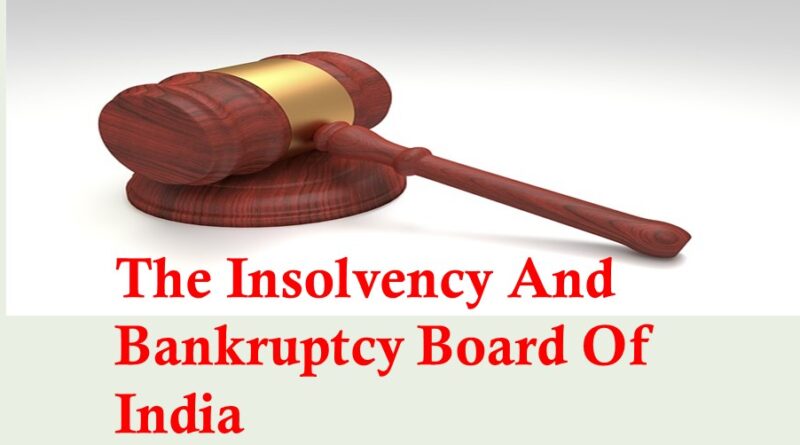The Insolvency and Bankruptcy Board of India
Ministry of Corporate Affairs
Context:
The Insolvency and Bankruptcy Code (Amendment) Ordinance, 2021 promulgated on 4th April, 2021 provides for pre-packaged insolvency resolution process (PPIRP) for corporate debtors classified as micro, small and medium enterprises.
Key Highlights
The Insolvency and Bankruptcy Board of India notified the Insolvency and Bankruptcy Board of India (Pre-packaged Insolvency Resolution Process) Regulations, 2021 (PPIRP Regulations) today to enable operationalization of PPIRP.
The PPIRP Regulations detail the Forms that stakeholders are required to use, and the manner of carrying out various tasks by them as part of the PPIRP. These provide details and manner relating to:
- Eligibility to act as resolution professional, and his terms of appointment;
- Eligibility of registered valuers and other professionals;
- Identification and selection of authorised representative;
- Public announcement and claims of stakeholders;
- Information memorandum;
- Meetings of the creditors and committee of creditors;
- Invitation for resolution plans;
- Competition between the base resolution plan and the best resolution plan;
I Evaluation and consideration of resolution plans;
- Vesting management of corporate debtor with resolution professional;
- Termination of PPIRP.
The PPIRP Regulations come into force from today.
The Insolvency and Bankruptcy Board of India
- It was established on 1st October, 2016 under the Insolvency and Bankruptcy Code, 2016.
- It is a key pillar of the ecosystem.
- It is responsible for implementation of the Code.
- The Insolvency and Bankruptcy Code consolidates and amends the laws relating to reorganization and insolvency resolution of corporate persons, partnership firms and individuals in a time bound manner.
Corporate Insolvency Resolution Process (CIRP)
- It is a recovery mechanism for creditors.
- If a corporate becomes insolvent, a financial creditor, an operational creditor, or the corporate itself may initiate CIRP.
- The CIRP may include necessary steps to revive the company.
- CIRP in a case under Insolvency and Bankruptcy Code, 2016 (IBC) needs to be completed in 330 days including time taken for litigation.
What is Insolvency And Bankruptcy Code?
Definition of Bankruptcy:
The legal status of an entity or a person where the debt owed to the creditors cannot be repaid is known as Bankruptcy. A court order imposes bankruptcy in most of the jurisdictions. It is mostly initiated by the debtor. It is important to note that bankruptcy is not synonymous with insolvency. It is not the only legal status that could be applicable to an insolvent individual or an entity. In countries like the UK, bankruptcy is exclusive to individuals. Liquidation, administration and other such insolvency proceedings are applicable to entities and companies.
The Insolvency and Bankruptcy Code, 2016 (IBC) is the bankruptcy law of India which seeks to consolidate the existing framework by creating a single law for insolvency and bankruptcy.
Objectives of IBC
- To consolidate and amend all existing insolvency laws in India.
- To simplify and expedite the Insolvency and Bankruptcy Proceedings in India.
- To protect the interest of creditors including stakeholders in a company.
- To revive the company in a time-bound manner.
- To promote entrepreneurship.
- To get the necessary relief to the creditors and consequently increase the credit supply in the economy.
- To work out a new and timely recovery procedure to be adopted by the banks, financial institutions or individuals.
- To set up an Insolvency and Bankruptcy Board of India.
- Maximization of the value of assets of corporate persons.
IBC – What does the Code aim to do?
The 2016 Code provides for a time-bound process to resolve insolvency. When a default in repayment occurs, creditors gain control over the debtor’s assets and must make decisions to resolve insolvency within 180 days. To ensure an uninterrupted resolution process, the Code also provides immunity to debtors from resolution claims of creditors during this period. The Code also consolidates provisions of the current legislative framework to form a common forum for debtors and creditors of all classes to resolve insolvency.
Who facilitates the insolvency resolution under the Code?
- The Insolvency Professionals: These professionals will administer the resolution process, manage the assets of the debtor, and provide information for creditors to assist them in decision making.
- Insolvency Professional Agencies: insolvency professionals will be registered with insolvency professional agencies. The agencies conduct examinations to certify insolvency professionals and enforce a code of conduct for their performance.
- Information Utilities: Creditors will report financial information of the debt owed to them by the debtor. Such information will include records of debt, liabilities and defaults.
- Adjudicating authorities: The proceedings of the resolution process will be adjudicated by the National Companies Law Tribunal (NCLT), for companies; and the Debt Recovery Tribunal (DRT), for individuals. The duties of the authorities will include approval to initiate the resolution process, appoint the insolvency professional, and approve the final decision of creditors.
- Insolvency and Bankruptcy Board: The Board will regulate insolvency professionals, insolvency professional agencies and information utilities set up under the Code.
What is the procedure to resolve insolvency in the Code?
The Code proposes the following steps to resolve insolvency:
- Initiation: When a default occurs, the resolution process may be initiated by the debtor or creditor. The decision to resolve insolvency: A committee consisting of the financial creditors will take a decision regarding the future of the outstanding debt owed to them. They may choose to revive the debt owed to them or sell (liquidate) the assets of the debtor to repay the debts owed to them. If a decision is not taken in 180 days, the debtor’s assets go into liquidation.
- Liquidation: If the debtor goes into liquidation, an insolvency professional administers the liquidation process. Proceeds from the sale of the debtor’s assets are distributed in the already established order of precedence.
Source: PIB

